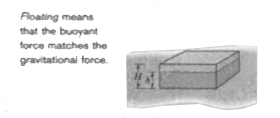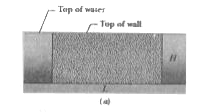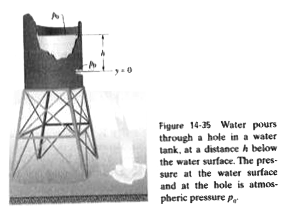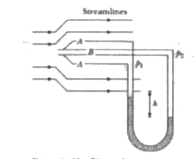SAMPLE PROBLEM 14.08 from RESNICK AND HALLIDAY PHYSICS (HINGLISH) FLUIDS for Class 12
| Class 12 | PHYSICS |
| Chapter | FLUIDS |
| RESNICK AND HALLIDAY PHYSICS (HINGLISH) | SAMPLE PROBLEM 14.08 |
| Medium | English |
| Academic Year | 2023-2024 |
Question 1
A living room has floor dimensions of 3.5 m and 4.2 m and a height of 2.4 m .
(a) What does the air in the room weigh when the air pressure is 1.0 atm ?
What is the magnitude of the atmosphere's downward force on the top of the your head .which we take to have an area of 0.040m2 ? View SolutionQuestion 2
A novice scuba diver practicing in a swimming pool takes enough air from his tank to fully expand his lungs before abandoning the tank at depth l. and swimming to the surface , failing to exhale during his ascent . At the surface , the difference Δ p between the external pressure on him and the air pressure in his lungs is 9.3 kPa . From what depth does he start ? What potentially lethal danger does he face ? View SolutionQuestion 5
In part a of Fig , a surfer rides on the front side of a wave , at a point where a tangent to the wave has a slope of θ=30.0∘ . The combined mass of surfer and surfboard is m = 83.0 kg , and the board has a submerged volume of V=2.50×10−2m3 . The surfer maintains his position on the wave as the wave moves at constant speed toward shore . What is the magnitude and direction (relative to the positive direction of the x-axis in part b of Fig) of the drag force on the surfboard from the water ? View SolutionQuestion 6
In Fig. , a rectangular block floats in a liquid . A block of mass m = 0.500 kg and density ρ=700kg/m3 floats face down in a liquid of density ρf=1200kg/m3 . What are the magnitude of the buoyant force on the block from the liquid , the weight of the liquid displaced by the block (liquid that would be in the space now occupied by the block ) , and the mass of that displaced liquid ? What fraction of the block's volume is submerged ? What fraction of its height is submerged ?
 View Solution
View SolutionQuestion 9
Three vessels having different shapes are shown in Fig , having the same base area and the same weight when empty . The vessels are filled with mercury to the same level . (Neglect the effect of the atmosphere) .

(a) Find which vessel has the maximum and which vessel has the minimum pressure at the bottom , or is the pressure same ? View SolutionQuestion 10
Three vessels having different shapes are shown in Fig , having the same base area and the same weight when empty . The vessels are filled with mercury to the same level . (Neglect the effect of the atmosphere) .

(b) Which vessel shows the maximum weight when weighed on a weighing scale or do they all weigh the same ? View SolutionQuestion 11
Three vessels having different shapes are shown in Fig , having the same base area and the same weight when empty . The vessels are filled with mercury to the same level . (Neglect the effect of the atmosphere) .

Even though mercury exerts the same downward force on the bottom of each vessel , then why do vessel weigh differently ? View SolutionQuestion 12
A conical vessel wihout a bottom stands on a table. A liquid is poured with the vessel & as soon as the level reaches h, the pressure of the liquid raises the vessel. The radius of the base of the vessel is R and half angle of the cone α and the weight of the vessel is W. What is the density of the liquid ?
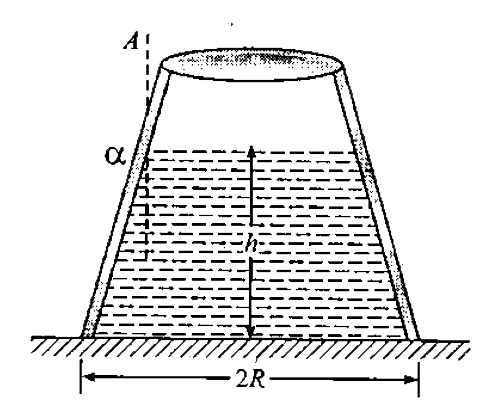 View Solution
View SolutionQuestion 13
The cross-section of a tank kept on a vehicle is shown in Fig. The rectangular tank is open to the atmosphere , During motion of the vehicle , the tank is subjected to a constant linear acceleration , a = 2.5m/s2 . How much fluid will be left inside the tank if initially the tank is half filled . The vessel is 5 m wide and 2 m high . View SolutionQuestion 14
The angular velocity , ω of a rotating body or shaft can be measured by attaching an open cylinder of liquid , as shown in Fig and measuring the change in the fluid level , H−h0 , caused by the rotation of the fluid . Determine the relationship between this change in fluid level and the angular velocity . Assume no fluid is spilling out of the vessel. View SolutionQuestion 15
A square with side b and rectangle with side b and 2b are cut out from two plates of equal thickness with densities of 3.5g/cm3 and 2g/cm3 , the square being cut out of the heavier material . The square and the rectangle are fastened together in the form of the letter L and placed upside down on the bottom of an empty vessel . Will the object be stable if the vessel is filled with water ?
 View Solution
View SolutionQuestion 17
Fig shows how the stream of water emerging from a faucet "necks down" as it falls . This change in the horizontal cross- sectional area is characteristic of any laminar (nonturbulant) falling stream because the gravitational force increases the speed of the stream . Here the indicated cross-sectional areas are A0=1.2cm2 and A=0.35cm2 . The two levels are separated by a vertical distance h = 45 mm . What is the volume flow rate from the tap ?
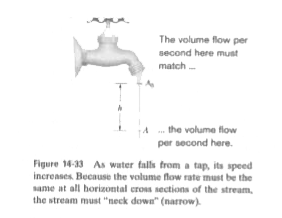 View Solution
View SolutionQuestion 18
Ethanol of density ρ=791kg/m3 flows smoothly through a horizontal pipe that tapers (as in Fig ) in cross-sectional area from A1=1.20×10−3m2 to A2=A1/2 . The pressure difference between the wide and narrow sectional of pipe is 4120 Pa. What is the volume flow rate Rv of the ethanol ? View SolutionQuestion 20
Many types of race cars depend on negative lift (or down-force) to push them down against the track surface so they can take turns quickly without sliding out into the track wall . Part of the negative lift is the ground force , which is a force due to the airflow beneath the car . As the race car in Fig moves forward at 27.25 m/s , air is forced to flow over and under the car . The air forced to flow under the car . The air forced to flow under the car enters through a vertical cross-sectional area is A1=0.0310m2 . Treat this flow as steady flow through a stationary horizontal pipe that decreases in cross-sectional area from A0 to A1 (Fig)
(a) At the moment it passes through A0 , the air is at atmospheric pressure p0 . At what pressure p0 . At what pressure p1 is the air as it moves through A1 ?
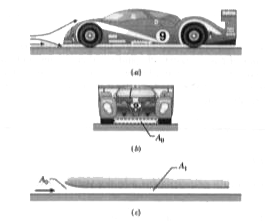 View Solution
View SolutionQuestion 21
Figure shows a siphon , which is a device for removing liquid from a container . Tube ABC must initially be filled , but once this has been done , liquid will flow through the tube until the liquid surface in the container is level with the tube opening at A . The liquid has density 1000kg/m3 and negligible viscosity . The distances shown are h1=25 cm d = 12 cm and h2=40 cm
(a) With what speed does the liquid emerge from the tube at C ?
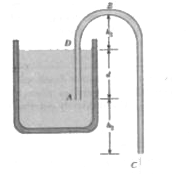 View Solution
View SolutionQuestion 22
Figure shows a siphon , which is a device for removing liquid from a container . Tube ABC must initially be filled , but once this has been done , liquid will flow through the tube until the liquid surface in the container is level with the tube opening at A . The liquid has density 1000kg/m3 and negligible viscosity . The distances shown are h1=25 cm d = 12 cm and h2=40 cm
If the atmospheric pressure is 1.0×105Pa, what is the pressure in the liquid at the topmost point B ? View SolutionQuestion 23
Figure shows a siphon , which is a device for removing liquid from a container . Tube ABC must initially be filled , but once this has been done , liquid will flow through the tube until the liquid surface in the container is level with the tube opening at A . The liquid has density 1000kg/m3 and negligible viscosity . The distances shown are h1=25 cm d = 12 cm and h2=40 cm
Theoretically , what is the greatest possible height h1 that a siphon can lift water ? View SolutionQuestion 25
A venturi meter is used to measure the flow speed of a fluid in a pipe . The meter is connected between two sections of the pipe (Fig) the cross-sectional area A of the entrance and exit of the meter matches the pipe's cross-sectional area a with speed v . A manometer connects the wider portion of the meter to the narrower portion . The change in the fluid's speed is accompanied by a change Δp in the fluid 's pressure , which causes a height difference h of the liquid in the two arms of the manometer. (Here , Δp means pressure in the throat minus pressure in the pipe).

(a) By applying Bernoulli's equation and the equation of continuity to points 1 and 2 in Fig show that
V=√2a2Δpρ(a2−A2)
where r is the density of the fluid . View SolutionQuestion 26
A venturi meter is used to measure the flow speed of a fluid in a pipe . The meter is connected between two sections of the pipe (Fig) the cross-sectional area A of the entrance and exit of the meter matches the pipe's cross-sectional area a with speed v . A manometer connects the wider portion of the meter to the narrower portion . The change in the fluid's speed is accompanied by a change Δp in the fluid 's pressure , which causes a height difference h of the liquid in the two arms of the manometer. (Here , Δp means pressure in the throat minus pressure in the pipe).
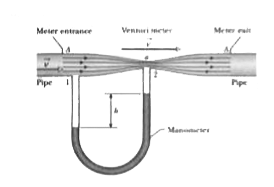
Suppose that the fluid is fresh water , that the cross-sectional areas are 64cm2 in the pipe and 32cm2 in the throat , and that the pressure is 55 kPa in the pipe and 41 kPa in the throat , and that the pressure is 55 kPa in the pipe and 41 kPa in the throat . What is the rate of water flow in cubic meters per second ? View SolutionQuestion 28
A tank has two outlets (i) a rounded orifice A of diameter D and (ii) a pipe B with well - rounded entry and of length L , as shown in Fig. For a height of water H in the tank , determine the (a) discharge from the outlets A and B , (b) velocities in the two outlets at levels 1 and 2 indicated in Fig .
 View Solution
View SolutionQuestion 29
Figure shows a self-acting water lifting device called a hydraulic ram . Its working is based on the phenomenon of hydraulic impact - when a liquid flowing along a tube is suddenly stopped , then there is a sharp increase in the pressure of the liquid . Its flow can be suddenly stopped , for example , by the shutting of a valve that discharges the water from the tube . A tube with a length of l = 2 m and a diameter of d = 20 cm is lowered into a stream with a current velocity of v = 4 m/s .
First let valve V2 be open and valve V1 be shut . A sharp increase in pressure will cause value V1 to open
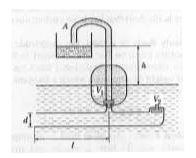
(valve V2 will close at the same time) and the water will flow up into vessel A . The pressure drops , value V1 shuts and V2 opens . The water in the tube assumes its course and the phenomenon is repeated in the previous sequence .
Find the amount of water raised by the ram in one hour to a height of h = 30 m if each valve opens thirty times a minute. View Solution
All Exercises from RESNICK AND HALLIDAY PHYSICS (HINGLISH) Class 12 PHYSICS FLUIDS
- CHECKPOINT
- PROBLEMS
- PRACTICE QUESTIONS (MORE THAN ONE CORRECT CHOICE TYPE )
- PRACTICE QUESTIONS (INTEGER TYPE )
- PRACTICE QUESTIONS (LINKED COMPREHENSION )
- PRACTICE QUESTIONS (MATRIX - MATCH )
- PRACTICE QUESTIONS (SINGLE CORRECT CHOICE TYPE)
- SAMPLE PROBLEM 14.01
- SAMPLE PROBLEM 14.02
- SAMPLE PROBLEM 14.03
- SAMPLE PROBLEM 14.04
- SAMPLE PROBLEM 14.05
- SAMPLE PROBLEM 14.06
- SAMPLE PROBLEM 14.07
- SAMPLE PROBLEM 14.08
- SAMPLE PROBLEM 14.09
- SAMPLE PROBLEM 14.10
- SAMPLE PROBLEM 14.11
- SAMPLE PROBLEM 14.12
- SAMPLE PROBLEM 14.13
- SAMPLE PROBLEM 14.14
- SAMPLE PROBLEM 14.15
- SAMPLE PROBLEM 14.16
- SAMPLE PROBLEM 14.17
- SAMPLE PROBLEM 14.18
- SAMPLE PROBLEM 14.19
- SAMPLE PROBLEM 14.20
- SAMPLE PROBLEM 14.21
- SAMPLE PROBLEM 14.22
- SAMPLE PROBLEM 14.23
- SAMPLE PROBLEM 14.24
- SAMPLE PROBLEM 14.25
- SAMPLE PROBLEM 14.26
- SAMPLE PROBLEM 14.27
- SAMPLE PROBLEM 14.28
- SAMPLE PROBLEM 14.29

